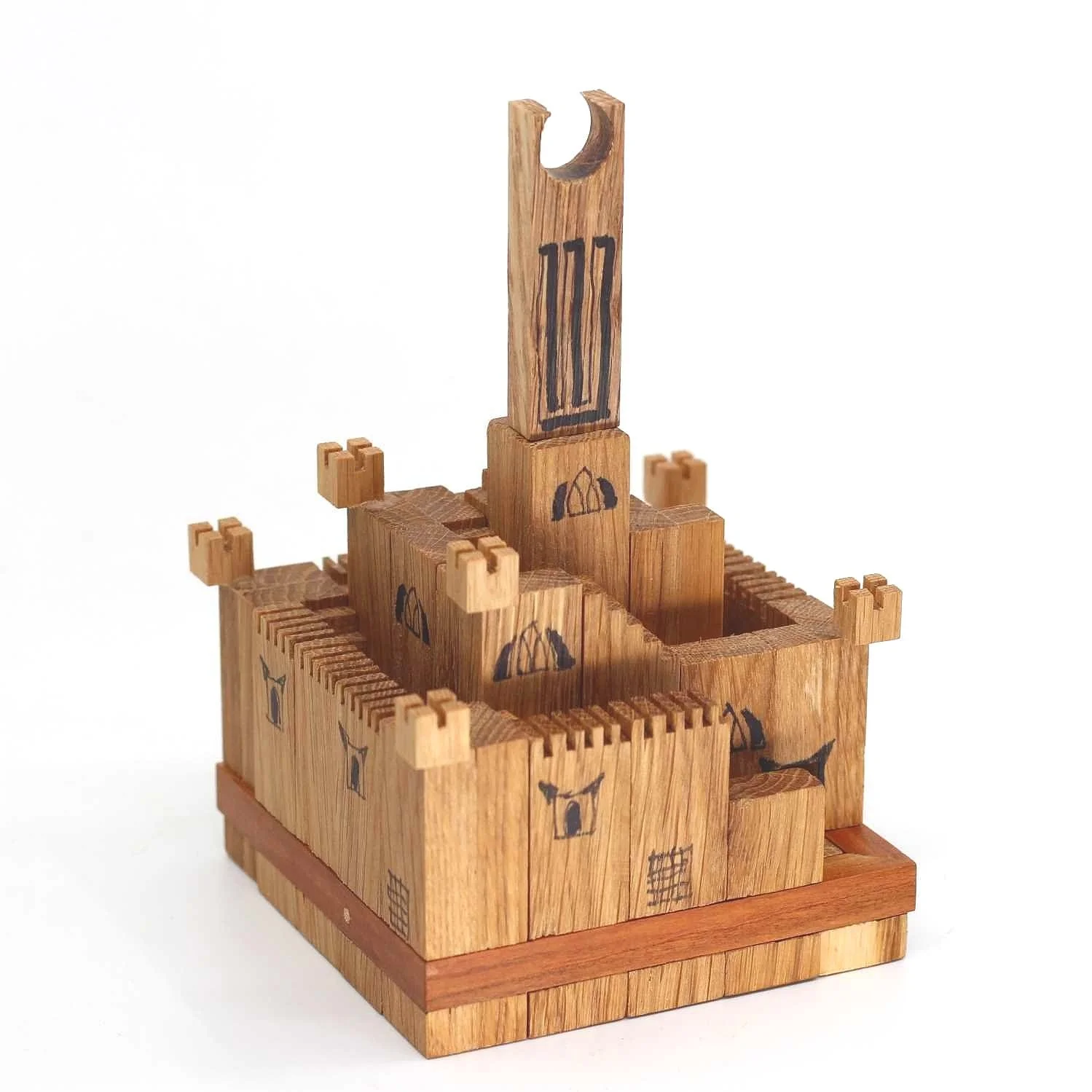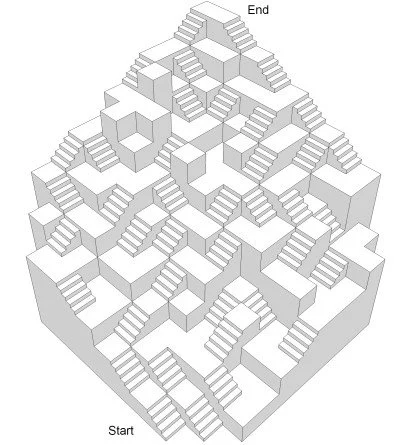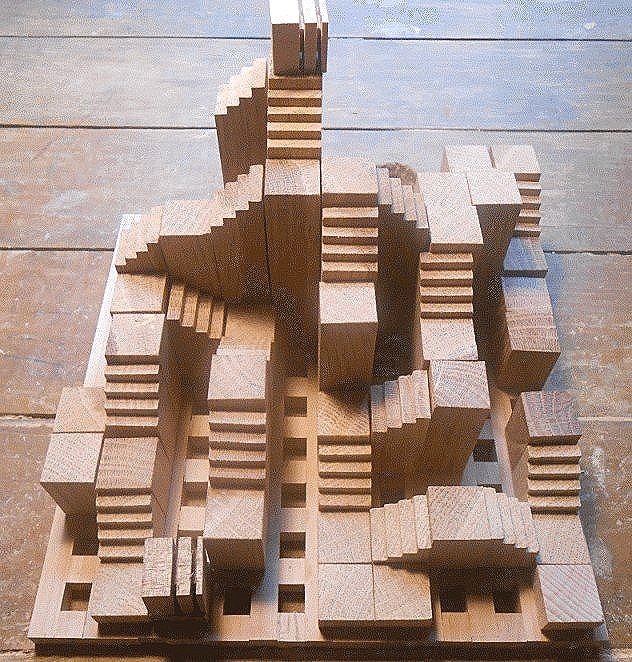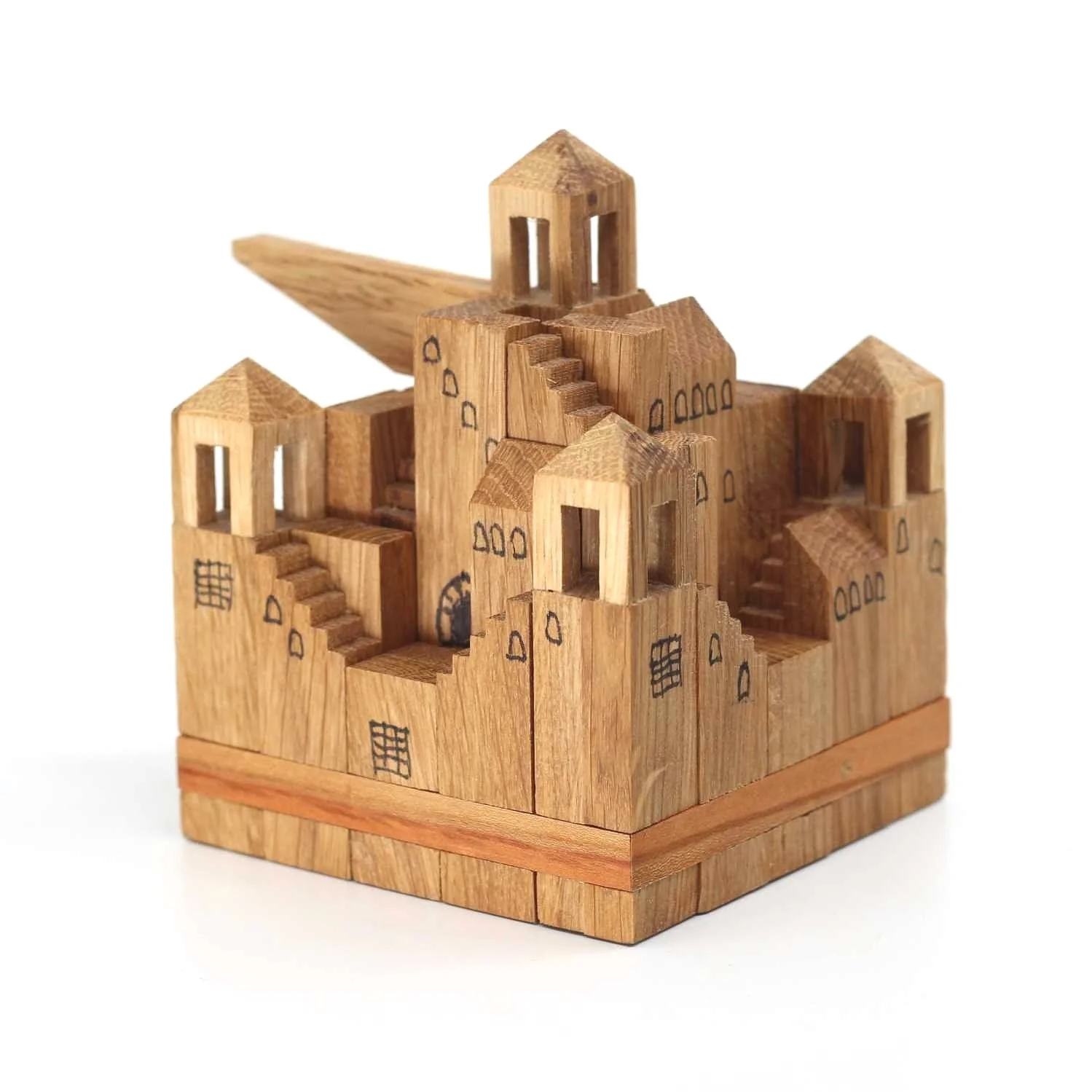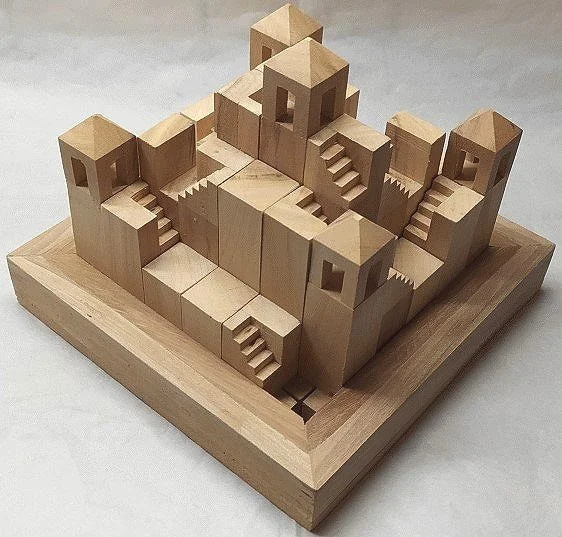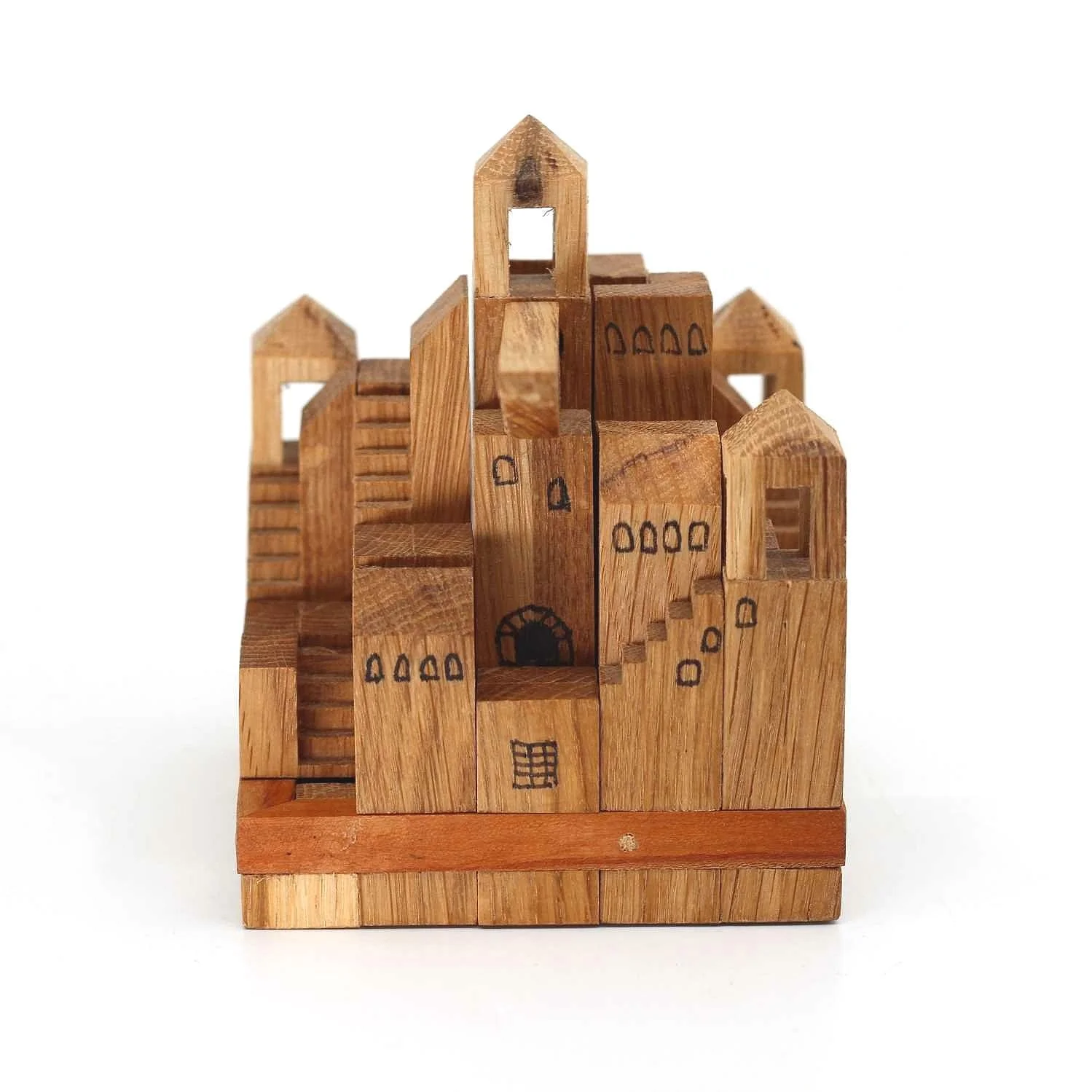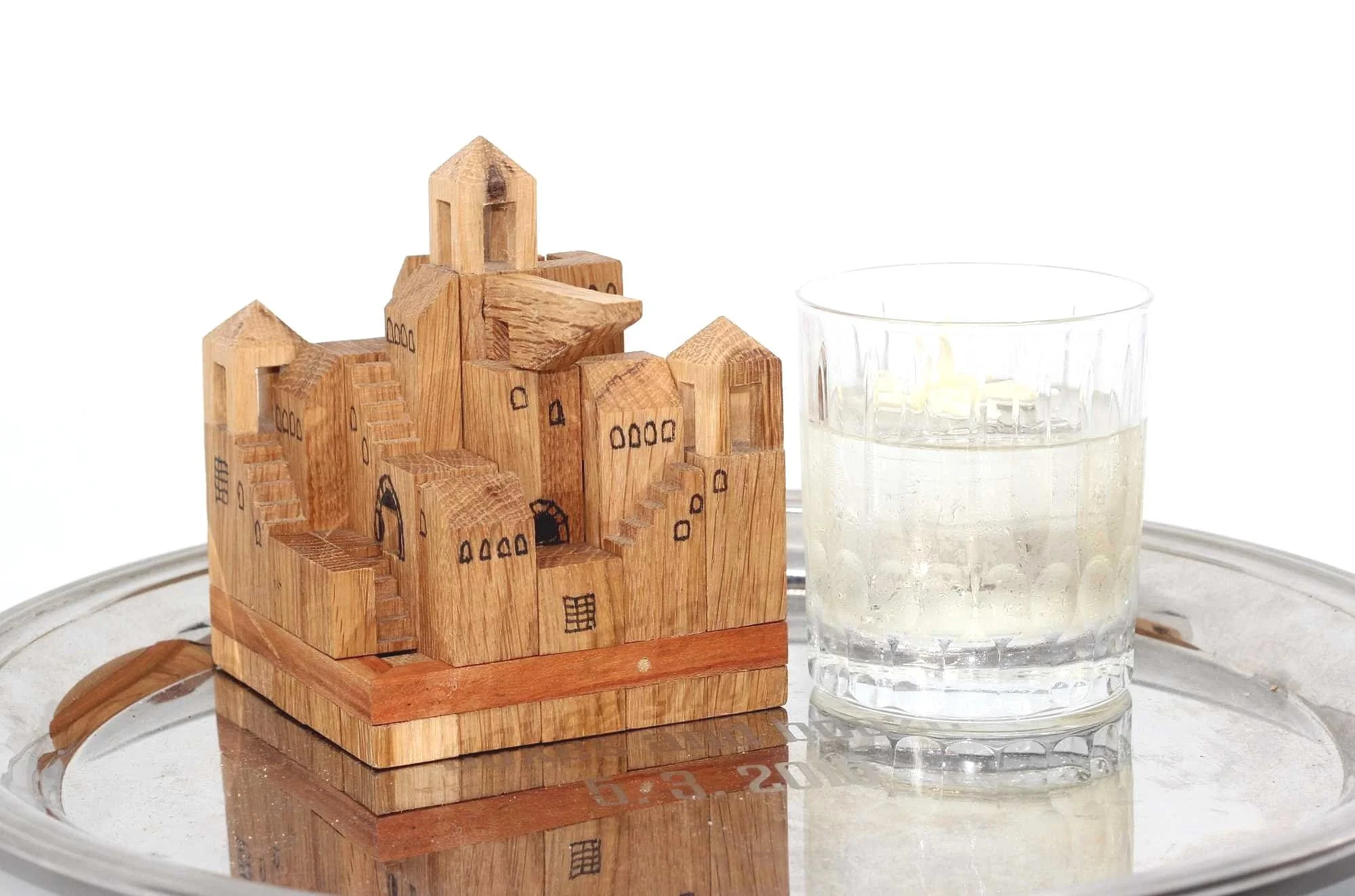White Castle
Minas Tirith / Barad-dur
Minas Tirith and Barad-dur by Tamas vanyo
Fans of Tolkien’s (and Jackson’s) Lord of the Rings saga will be well familiar with the many regal palaces encountered within Middle Earth, from the ethereal vistas of the elven kingdoms to the depths of the dwarven mines. Tamas Vanyo, a software engineer from a small village in Hungary, is also a prolific hobbyist puzzle designer with a penchant for complex and creative interlocking creations. They may not be puzzle boxes, but as a huge fan of Tolkien’s world myself, I couldn’t resist Tamas’s magical maze homages to the opposing light and dark forces of those stories.
Minas Tirith
He has recreated two fortresses, the dark tower Barad-dur which sits within Mordor in the shadow of Mount Doom and is home to the evil sorcerer Sauron, who’s always seeking “eye” blazes from the top of the castle tower, ever searching for the one ring, and Minas Tirith, the capital and guard tower of the white city of Gondor, the last stronghold of men against the dark forces. Tamas has created a unique game along this theme, a pair of castles composed of twenty five columns each which must be fit together inside a slightly restricted ringed base. Many configurations may be possible, but the correct one, in addition to looking grand, will allow access to a secret hidden maze which tunnels its way inside. A small metal ball may then be dropped into the top, and can be navigated (beware of false paths and dead ends!) through to the exit. The multilayered challenge is not as daunting as it seems, once you take the first step out the door, and Tamas’ construction is reliable and allows for a truly enjoyable experience. His personal artwork which adorns the pieces adds an incredibly charming touch.
Barad-dur
Tamas recently shared his story with me. “I loved puzzles even as a child, but more seriously, I started dealing with them 10 years ago. A blog caught my attention, and then I found more and more things on the Internet about this topic. This is how I got to the puzzleswillbeplayed website. Based on the plans there, I started making wooden toys for myself, and then I thought: hey, I could design these too. On the mentioned page I found the designs of Stéphane Chomine, Yavuz Demirhan, Alfons Eyckmans. These were designs for classic interlocking puzzles. I liked the forms and the degrees of difficulty. I made a few of them and learned how to use the BurrTools program along the way. This was necessary, especially to solve Stéphane's multi-step games. From this came the inspirations for designing interlocking puzzles. During the planning process, I followed my own path:
- simple interlocking puzzles,
- more complicated, multi-step variations,
- toys that cannot be completely dismantled.
I've always liked mazes and games with special shapes, so I ended up with these.
2D and 3D mazes
photos courtesy of Tamas Vanyo
I've been making staircase maze puzzles for a long time, which have been published in Games Magazine and puzzle magazines in the UK. From the paper-based "3D" puzzles, I then made real 3D toys from wood. A maze building set and a board game called Stamabu have already been made. I also offered the latter to the manufacturer Thinkfun, but it did not become serial production. Anyway, the idea of games with stairs remained with me.
Stamabu maze building set and boardgame
photo courtesy of Tamas Vanyo
The Barad-dur and Minas Tirith games were inspired by my previous games and readings. Of course, the LotR illustrations and the movies about these fortresses also played a role. The square design of the games does not allow for a real likeness, but 2 distinctive signs may make them recognizable: the tower of Barad-dur with the all-seeing eye and the horizontal ramp of Minas Tirith. I've read the books several times. I also love the illustrations of the painters (for example, those of the Hildebrandt brothers).
“He that breaks a thing to find out what it is, has left the path of wisdom.” - J.R.R.Tolkien
I have an interesting story about the books. I first read The Lord of the Rings, where the translator used the term “hobbit”. Later, I read the prequel book, where another Hungarian translator used the term "babó" and gave the trolls a different name, the whole book became like a fairy tale. After the success of the movies, The Hobbit book was re-translated and the word “hobbit” is used in it. The translator of the books was Árpád Göncz, who later became the President of the Republic of Hungary.
“But in the end it’s only a passing thing, this shadow; even darkness must pass.” - J.R.R.Tolkien
The design challenge was to create a simple interlocking game. With a variety of movable elements in one frame, which do not fall out, but can be removed after a few movements. The decorations on the elements (e.g. a small bastion) should not hinder movement. The production was not easy due to the complexity and diversity of the elements. Square columns had to be made, with half steps at the end, and empty parts at the bottom for movement in the frame. These could have been made with a very small milling machine, but since I don't have one, I solved the square column from two half columns. The end of these, especially the stepped part, could already be easily worked with a table saw. During the [process], the idea came to have an inner tunnel in the castle, through which you can roll a ball from the top to the bottom. I was also able to saw these passages out of the half-columns. Then I glued the half columns together and got the 25 square columns. It was also a challenge that no two elements are the same, and dead ends were also needed in the inner tunnel. After gluing came decorating the elements, gluing small elements, drawing windows and doors, oiling, and assembly. I made only a few of these toys. I work full time and have little free time to make puzzles, even though these games require a lot of time.
Castle Builder Sets 1 and 2
photos courtesy of Tamas Vanyo
I developed [the idea] further; I made several other stair games. One is the Castle Builder set, which is a classic Sam Lloyd 15 game. In a frame, elements must be rearranged according to a certain rule. Here, stepped square columns move in the frame. They cannot be taken out, they can only slide back and forth to the 1 empty space. The goal is to create a layout where you can go up the stairs to the highest column. Castle Builder set 2 was also made from this on a similar principle, but there the movable elements are wider and there is a separate place for exchanging the elements.
Moving Castle
photo courtesy of Tamas Vanyo
Fortress
photo courtesy of Tamas Vanyo
Next up was the Moving Castles game, which features two tiers, stairs, towers, interlocking elements and a frame. The goal is to find a layout that allows you to go all the way to the opposite corner on the top side, and then come back to the starting point at the bottom of the game. The inspiration came from M. C. Escher's drawings, and the name was given by a Japanese anime. I also made a staircase game called Fortress, where the sides of a cube have staircase, bastion, and tower routes. This game is heavy, in the original sense of the word.
“The wide world is all about you: you can fence yourselves in, but you cannot forever fence it out.” - J.R.R.Tolkien
I once heard a master being asked about making something. He answered with noble simplicity: let's figure it out and do it
I'm not a master, but that's how I do it. Game ideas can come from anywhere (from an illustration, a statue, a building) and at any time (sitting on the bus, in the morning at the swimming pool). After the idea comes the design, mostly with the BurrTools program. Based on the finished plan, I plan, cut, glue, oil, and assemble the slats with my home hobby carpentry machines. The design excites me the most, the process of making it as well, I like playing the least. Fortunately, there is someone in the family who likes to play with these wooden toys. I am a hobby carpenter, I did not study the trade, I discover new techniques while working. I always learn something new. For example, that a circular saw is not a toy. I cut my finger once; it took a long time to heal. I also experienced how important sizing is, so I bought a small hobby planer, which I use to shape the slats to the exact size, and I also got a professional caliper from my friend. I used oak and walnut (frame) for Barad-dur, and cherry for the whole Minas Tirith. I use local woods for puzzles: acacia, peach, beech, cherry, walnut, maple, pear, oak.
“The wise speak only of what they know.” - J.R.R.Tolkien
I have many new puzzle ideas. BurrTools is almost always running on my computer. My wife always used to say - when I looked confused - what are you planning again? I also used to tell her that I invented a new game. Fortunately, she tolerates things. Sometimes I want more free time to make puzzles, but not because I have to do it all the time. It's a hobby and I want it to stay that way. I'd like to design an N-ary puzzle someday, I'd like to get to an IPP someday. I am constantly designing and making with varying enthusiasm, but I think I will remain a puzzler forever. The designs of my puzzles are published on the aforementioned puzzlewillbeplayed website, but I also created my own website, which can be viewed at vanyotamas.hu. The essence of my puzzle life so far is that I have made these plans for my own pleasure; if I have also brought pleasure to others, that is just an added bonus.”
The White Tree
To honor the wonderful story behind these awe inspiring creations and their humble creator, I created a cocktail that continues the story. After some unsatisfying research into Lord of the Rings cocktails, I accepted the idea that I would need to make something suitable myself. I had to embrace Tamas’s wise words: “lets figure it out and do it.” I admit, I like making new cocktails, so it was a challenge I readily embraced. It turns out, I once made a cocktail based on Sauron, the dark sorcerer, to celebrate a magical puzzle box that holds the One Ring. So I turned my attention to the White City instead, this time, focusing in on its most emblematic symbol, the White Tree of Gondor. The tree stands brittle and barren, dead in the courtyard at Minas Tirith during the time of the Lord of the Rings saga, a far cry from the beautiful, regal tree full of white flowers and fruit described in the days of the Kings. The dead tree was a descendant of many others, all grown from an original sapling of Nimloth, the ancient tree of Numenor, and remained as a prophesy to herald the return of the true king someday by blooming once again. In the movies, this rebirth of the tree occurs as if by magic, while in the original story by Tolkien, a new tree is planted.
“It is not the strength of the body, but the strength of the spirit.” - J.R.R.Tolkien
The type of tree, flower and fruit is never fully explained and remains unattainable beyond the descriptions. The white flowers are reminiscent of jasmine flowers, as close as I could determine. Of course, this cocktail could have gone in any direction, but I tend to gravitate toward the bittersweet and I love a Negroni, so there you are. White Negronis often use alternate clear spirits like mezcal, which make for an excellent drink, and pale bitters or aperitifs such as Suze or Cocchi Americano to replace the bright red Campari. French vermouth, based on white wine, typically replaces the Italian sweet red vermouth. The flavors end up similar but the drink is pale straw or light yellow, looking nothing like a traditional Negroni. For the White Tree I made a practically clear drink, achieved with Bitter Bianco, an amaro with the full complexity of a typical red hued bitter but which has undergone a filtration to remove all color. Most red amaro like Campari is actually dyed with food coloring anyway. I stuck with gin for this one, to highlight the botanicals, and infused it with jasmine to complete the effect. Here’s to the stories, may they ever inspire us. Cheers!
“Don’t adventures ever have an end? I suppose not. Someone else always has to carry on the story.” - J.R.R.Tolkien
The White Tree
1 oz jasmine infused gin
1 oz Luxardo Bitter Bianco
½ oz dry vermouth
½ oz fino sherry
Stir ingredients over ice and strain into a favorite glass over a large clear cube. White citrus peel flower garnish.
explore more:



